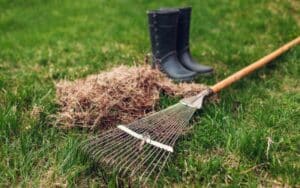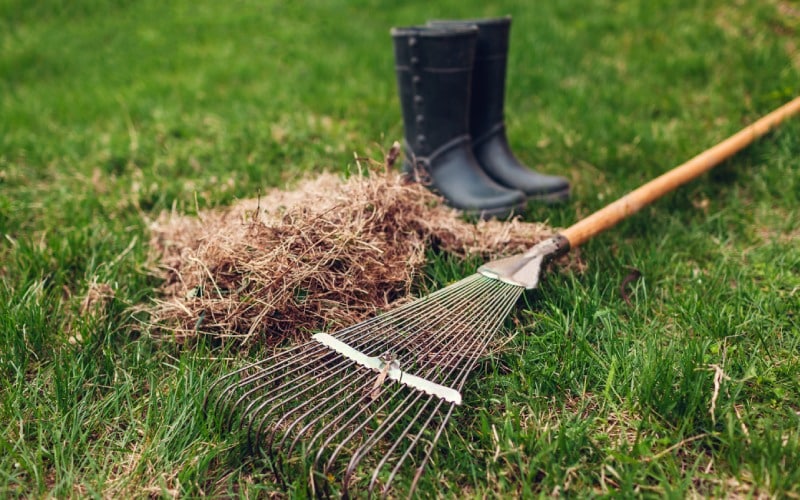Why Fall Landscaping Matters

The cold temperatures are a major deterrent, as is a pile of snow on the ground. For that reason, you need to get your yard ready for the lack of attention. Any debris on your lawn will just sit there. Likewise, any dying flowers or branches will remain on your trees and flowers.
Fall landscaping ideas can protect your yard from the cold winter. Although you can’t ensure the survival of everything, you can do your best to protect your landscaping.
Top Fall Landscaping Ideas
1. Top Fall Landscaping Ideas
Some gardeners mulch in the spring. However, this isn’t the best practice. If you mulch in the fall, you can give shrub and tree roots and extra barrier from the cold. The mulch protects the roots and keeps the ground moist. As a result, your plants might make it through the winter.
For fall mulching, you should spread between two and three inches of mulch around your trees and shrubs. Be cautious about the source of your mulch. If you get mulch from free county or city piles, you put your plants at risk. Typically, free piles of mulch come from dead and sick trees. They have disease spores and can spread the disease to your garden.
Your best mulching option is hardwood. If you visit your local home or garden center, you can buy bags of shredded hardwood mulch. Made from healthy trees, these bags of mulch don’t contain the disease. They keep your plants safe throughout the winter.
2. Protect Your Shrubs
Unlike most tree species, shrubs tend to be delicate. If you have one of the many delicate species of shrubs, you need to prepare it for the long winter.
Ice, snow, and wind can wreak havoc on your shrubs. To protect them from the elements, give them a barrier. One simple way to do this is to hide them under pots or buckets. An alternative is to wrap them in burlap.
There are a few tree species that need protection. If you have any vulnerable trees, place piles of dead leaves at the base of them. The layer acts as a barrier against the cold.
3. Get Rid of Dying Foliage
In the fall, pruning can damage your plants. Pruning signals your plants to grow, which is unhealthy with the approaching winter. That said, you shouldn’t hesitate to cut off the dead leaves and flowers in your garden. Pruning is very different than removing the dead. By removing dead growth, you can prepare for winter. It prevents the plant from wasting energy on dead branches and flowers. Additionally, it prevents you from staring at dead blooms all winter long.
First, you should start by completely removing your dead annuals. Cut off dead flowers and leaves. Perennial flowers and dried grasses also require some attention. Cut as much of the dead off, only leaving the living parts of the plant.

If you have any trees or shrubs, do the same. However, you should be cautious. Don’t cut any healthy branches, and avoid cutting stalks that are not completely dead yet. Hydrangeas have stalks that look dead, but turn into buds when the spring arrives.
4. Prepare Your Roses
If you have any trees or shrubs, do the same. However, you should be cautious. Don’t cut any healthy branches, and avoid cutting stalks that are not completely dead yet. Hydrangeas have stalks that look dead, but turn into buds when the spring arrives.
5. Do Some Planting
You might imagine that the fall is a terrible time to plant shrubs and trees. However, the opposite is true. In the fall, the cold weather is easier on your new additions. There is also enough water to keep them thriving.
Another benefit to fall planting is the affordability. In the winter, many nurseries and home centers have plant sales. As they scramble to sell their inventory, they mark down prices. You can get some great deals.
Fall is also the time to plant some bulbs, so you can enjoy those spring tulips!
6. Continue to Cut Your Lawn
It might be cold outside, but you should continue to cut your lawn in the fall. As certain blades of grass get long, they shade the grass next to them. This could kill off some of your grass.
There’s another good reason to mow in the fall. If your grass is too long when the first snowfall arrives, it will become compact. Then, mold can form. You should try to keep your grass about three inches long. Once it stops growing, you can stop mowing.
7. Plant Grass Seed
If you have any areas of your yard that you want to seed, the fall is the time to do it. The weather is optimal for growth. However, you need to take one precaution before you start planting.
Before you plant grass seed, check your soil quality. If you have a pH that is too low or too high, your grass won’t grow well. You also should check for the nutrients in your soil. You might need fertilizer to give the seeds a good chance at success.
8. Plan for the Spring
As the winter approaches, you should start planning for the spring. Draw up any ideas that you have for spring planting. If you need to get rid of any garden features, remove it before the winter arrives.
Over the winter, you can fine-tune your garden plans. When the cold weather is over, you can get started on landscaping your yard.















